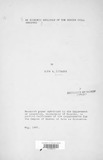| dc.description.abstract | Kenya is an important producer of sisal fibre
in the world market. The sisal crop not only provides
cash income to producers but is also an important source
of foreign exchange resulting from exported fibre and fibre produc
However, the Kenya sisal industry not only faces stiff
competition from other fibres thereby reducing its market
share, but also faces constraints that adversely affect
production. Some of these constraints led to the contraction
of the sisal industry from 1960 to 1985.
This study investigated producers' production
behaviour. In particular, a sisal production system
that consists of factors that motivate acreage, harvesting,
I labour, production, sales, and stock of sisal fibre is
identified. A model is developed to identify and estimate
the effects of these factors.
Other issues that affect sisal processing and
marketing are also discussed. A'comparison of the two
techniques, the "fiel~" and "factory" decorticators is
discussed. This is based on production costs, revenues, and
opportunity cost)of wasted fibres in the drums per ton
of finished fibre to determine the appropriate technology.
Marketing arrangements for sisal fibre, the roles
of the Sisal Board and the marketing agents and
the international fibre market are evaluated and
discussed. | en |

